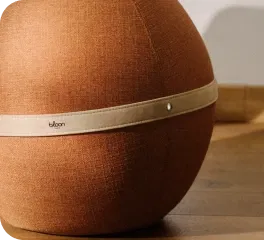Do you have ADHD and your work environment is significantly impacting your ability to stay focused and productive? Creating an ADHD-friendly workspace to promote concentration while limiting distractions isn't always easy, but it's definitely doable.
Between thoughtful planning and adjustments tailored to your needs, you can create a framework that truly supports you. Whether you work from home, in an office, or in a shared space, our simple yet effective tips can help you better manage your ADHD at work.
Understanding ADHD Needs at Work
Concentration problems
People with ADHD often have difficulty maintaining focus on long or repetitive tasks. This can lead to frustration, especially in work environments where interruptions are frequent.
To promote a better ADHD-friendly workplace, minimize distractions and sensory stimulation. This may include using noise-canceling headphones, setting aside quiet spaces for high-attention tasks, or setting aside time slots for specific activities.
The right layout can turn concentration challenges into productivity opportunities.
Difficulty getting organized
Organization can be a real headache for professionals with ADHD. Between emails, meetings, and deadlines, it becomes difficult to prioritize tasks. Organizational difficulties in people with ADHD often stem from specific brain functions.
Impulsivity, a common characteristic of ADHD, can also lead to disorderly task management, with a tendency to move from one activity to another without completing them.
These combined factors make daily organization complex and sometimes frustrating.
Time management
Time management can be a major challenge for someone with ADHD. This is due in part to an altered perception of time, often referred to as "time blindness."
Individuals with ADHD may have difficulty accurately estimating the time it will take to complete a task or anticipating deadlines. This difficulty is further compounded by a tendency to become easily distracted, which fragments attention and makes linear progress on an activity particularly challenging.
Time management, for example, can be a real challenge due to a different perception of it, making it difficult to assess the time needed to complete a task. Furthermore, prioritization mechanisms can be disrupted, with a tendency to focus on less important details at the expense of the main objectives.
Tendency to procrastinate
Procrastination, on the other hand, can be rooted in a difficulty initiating tasks perceived as boring or complex, as well as a need for immediate stimulation. As a result, deadlines often fall into a cycle of urgency, where efforts become reactive rather than planned, thus amplifying stress and feelings of overwhelm.
Designing an ADHD-Friendly Workspace
Use active sitting for ADHD
To meet the needs of ADHD-friendly workplace design, ergonomic seating, such as the Bloon active seating can be very beneficial.
Bloon Active Seating is distinguished by its ability to encourage constant micro-movements, allowing people with ADHD to stay active and maintain a more sustained focus by channeling some of the often overwhelming energy associated with ADHD.
Additionally, Bloon Dynamic Seating promotes better posture and engages deep core muscles, providing the benefits of light physical activity while working.
The Bloon ball chair combines well-being, productivity, and mental stress management. This chair is therefore a key element for a workspace designed for ADHD.

Try standing
Sit-stand desks provide an alternative to traditional sitting. Alternating between sitting and standing helps combat boredom and promotes concentration.
By facilitating a dynamic posture, this work arrangement for ADHD helps you stay active while working more efficiently.
To learn more about this topic, please read our article on the benefits of standing at your desk.
Opt for a sitting position with your feet moving
A wobble footrest or accessories like elastic bands under the chair offer simple, yet effective, solutions to channel the restlessness of people with ADHD.
These ADHD workplace design options allow you to move discreetly, without creating distractions in the open-plan office.
Choose the right lighting to improve your concentration
Avoid harsh, bright lighting, which can overstimulate. Instead, opt for soft lighting, which is essential for reducing eye strain and maintaining focus. An adjustable desk lamp or well-utilized natural light can be part of an ADHD-friendly workspace.
Limit visual and audio distractions
Using desk dividers, organizing your space to avoid distracting objects, or investing in noise-canceling headphones can greatly improve concentration. These simple adjustments are essential for setting up your workspace for ADHD.
Add calming elements like plants or stress-reducing objects
Green plants, stress-relieving objects, and minimalist decor add a calming touch to the workspace. These elements contribute to a balanced ADHD workplace design and help create a serene atmosphere.
Optimize the organization and tools in your workspace
Use colors to structure space and promote concentration
Colors can be a powerful tool for structuring and clarifying your workspace. For example, folders of different colors can indicate priority levels, making ADHD workspace design more intuitive and engaging.
Create dedicated areas for different tasks
A well-structured space can include different areas for specific activities: one for thinking, one for calls, or one for creative tasks. This type of workplace design for ADHD allows each space to be associated with a specific energy, facilitating engagement.
Use simple and visible storage systems
Open shelves, labeled boxes, or charts with visual reminders make work tools easily accessible. Simplifying organization is a key to any ADHD workplace design to reduce wasted time and focus.
Apply the Pomodoro method
Encouraging the Pomodoro method in daily routines improves performance. Dividing work into 25-minute periods with short breaks makes tasks more manageable and allows for progress without overworking. This ADHD workplace arrangement promotes productivity.
Follow the 2-minute rule
To combat procrastination, the 2-minute rule involves immediately completing any task that takes less than 2 minutes. This practical tool fits perfectly into an ADHD work environment, preventing the accumulation of small tasks.
FAQ: ADHD and Workplace Adjustments
Can I get accommodations for ADHD?
Yes, it is entirely possible to obtain workplace accommodations for ADHD, often in collaboration with the employer or human resources.
What workplace adjustments are available for ADHD?
Accommodations for ADHD may include time management tools, a personalized workspace, or regular breaks to maintain focus.
What are reasonable accommodations for ADHD?
Reasonable accommodations vary depending on specific needs, but may include flexible hours, the ability to work remotely, or an adjusted desk to reduce distractions.
How to manage ADHD at work?
Better management of ADHD at work requires appropriate design, effective organizational tools, and well-established routines. Taking regular breaks and creating a calm and structured environment are also essential.












